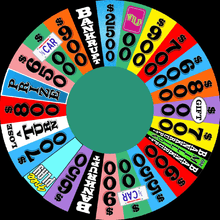La Ruota Della Fortuna
La Ruota Della Fortuna is the Italian version of Wheel of Fortune. The show has run nonstop since 1989 on Rete 4 and Canale 5, and switched from a trilon to an electronic board in 1997, like the U.S. version.[1] previously hosted by Mike Bongiorno, the show was hosted by Enrico Papi on Italia 1, and featured Victoria Silvstedt from the French version of the show, La Roue de la Fortune. The Italian version of Wheel went off the air in 2009.
In 1985, the show was one of several game shows that was part of the television series, Pentatlon, which was also hosted by Mike Bongiorno. The show aired on Canale 5. The wheel had 15 wedges compared to the 24 in the 1989-2009 version.
From September 1987 to 1988, the show aired on Odeon TV. This version had the shopping element that the U.S. version, along with several other versions at the time, had. This version did not have Mike Bongiorno as host.
Differences in Gameplay Compared to American Version
The Electronic Board (2003-present)
This is the only board in the world where if more than one letter was revealed, the hostess only had to touch one and all would simultaneously appear.
The Wheel

When the show was on 'Pentatlon' using Italian Lira as its currency, the 15-wedge wheel configuration ran from ₤100,000 to ₤1 Million. On the Odeon version, the number of wedges increased to 24, and amounts ranged from ₤50,000 to ₤1,000,000. In round 3, the amounts increased with ₤100,000 as the smallest and ₤3,000,000 as the biggest.[2] In 1989, ₤1,000,000, ₤1,300,000, and ₤2,000,000 were the top amounts of the first three rounds. The following year, the smallest amount of ₤200,000 increased to ₤300,000, and ₤1,000,000 became the top amount for the first two rounds. This changed from €150 to €500 (€200 to €1,000 in round 3) when Italy decided to go to Euros in 2002. From 2000 to 2002, however, a blue band was inserted at the wheel's edge showing the euro value equivalent to each corresponding wedge. For example, a wedge worth ₤300,000 had a blue band noting that the same wedge was worth €154.94. In 2002, euro and lira values swapped positions. By 2003, the band was removed, and the euro values were changed again, ranging from €50 to €300 (€100 to €600 in round 3). [3]
Values were displayed in thousands of liras from 1989 to 2002. That meant if a player landed on a wedge that had the number 300 on it, the player would be playing for ₤300,000.
In the American version, the view of the podiums from left to right are the host, red player, yellow player, and blue player. The 2007-2009 Italian version was reversed, making this version one of the few versions of Wheel of Fortune to show the host on the right side of the players' podiums instead of the left. The original version with Mike had different changes in the podium colors: red-yellow-blue, red-yellow-green, orange-yellow-green, blue-yellow-green, and finally blue-yellow-red like the 2007 version.
The most recent version adopted two rules from the French version by putting a €0 on the wheel, meaning players keep their turn but earn nothing for a correct letter, and also the "Cave" feature. The Lose a Turn wedge is known as "Passa" and the Bankrupt wedge is "Perde" or "Bancarotta".
The Free Spin
This was referred to as a "Jolly," due to the clown picture being on the token. It had to be earned with a correct letter, and could be turned in if a mistake was made. On 'Pentatlon," it was named Bonus. On the 1987 Odeon version, it was known as Rilancia.
Bonus Round
Played exactly the same as the American version. In the 1990s and early 2000s, players chose from three random envelopes (similar to the "WHEEL" envelopes in the early 1990s in the US); from 2007 to 2008, they spun a miniature wheel with prizes ranging from €50,000 to €200K, or a new car. From 2008 until the end of its run in 2009, the top prize of €200K was halved to €100K.
References
- ↑ See the Wheel of Fortune (US game show) article for more details on gameplay.
- ↑ http://www.giralaruota.it/story1.html
- ↑ http://www.giralaruota.it/format.html
| |||||||||||||||||||||||||||||||||||
